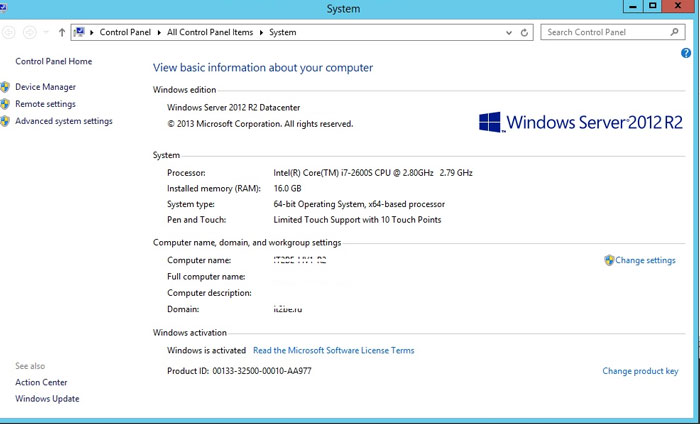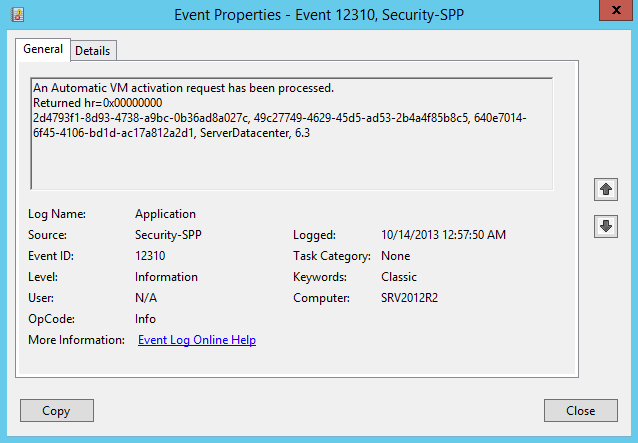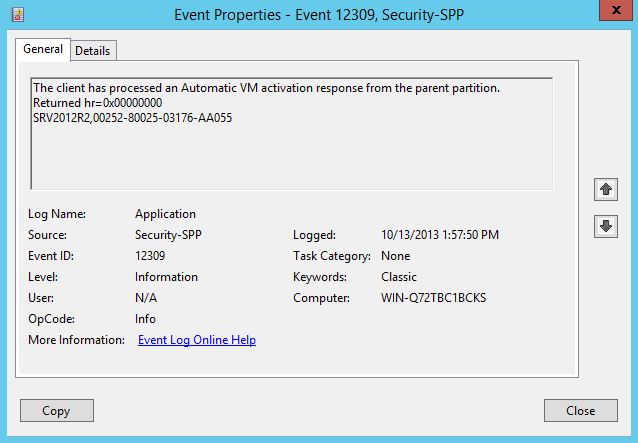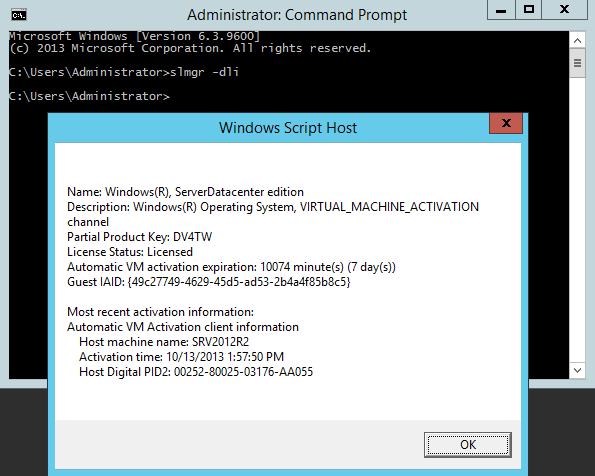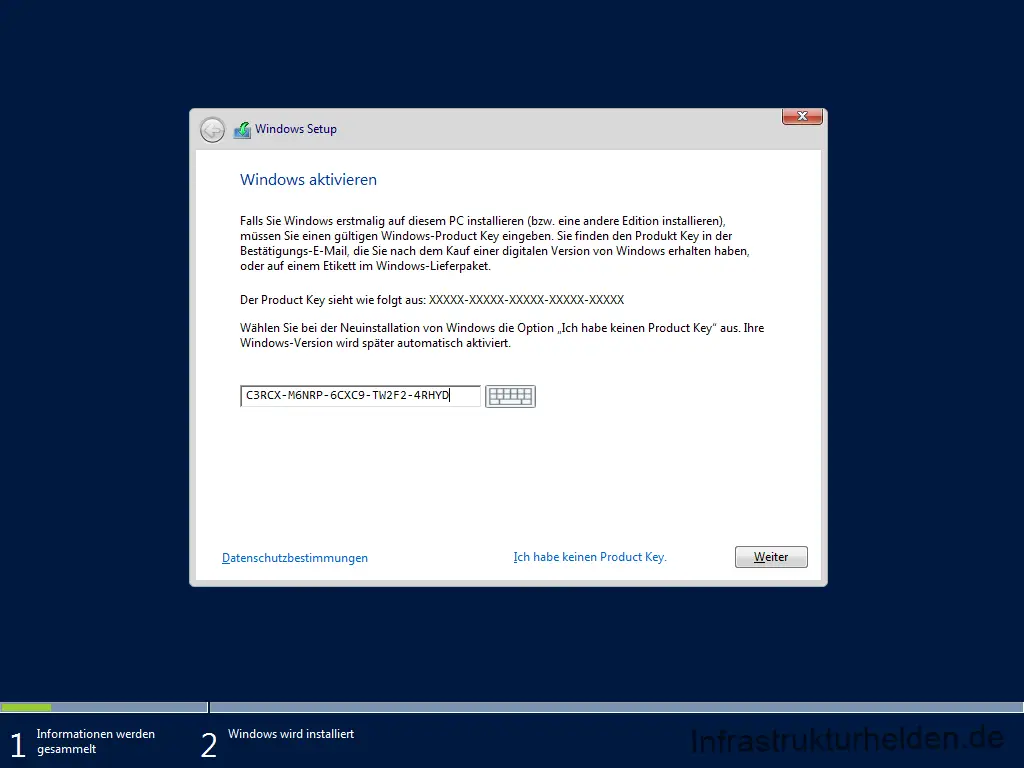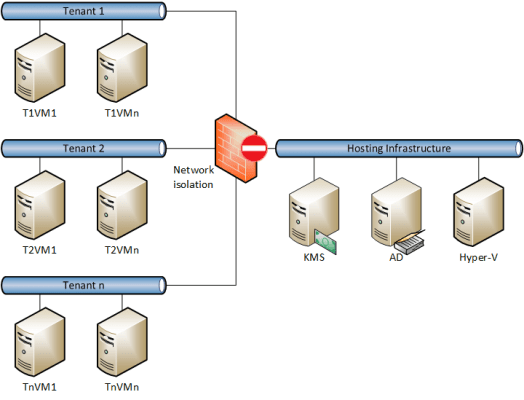В этой статье мы познакомимся с новым типом лицензирования и активации, представленном в Windows Server 2012 R2, под названием AVMA (Automatic Virtual Machine Activation), о которой вы упоминали в нашем обзоре Hyper-V 2012 R2, но сначала сделаем небольшой обзорный экскурс по основным способам активации продуктов Microsoft. Итак, начиная с Windows Vista, все продукты Microsoft требуют обязательной активации, не зависимо от типа используемого ключа. И OEM и retail и корпоративные версии – обязательно должны быть активированы на сервере активации Microsoft. Чтобы упростить корпоративным заказчикам процедуру активации и управления ключами продуктов, Microsoft ввело понятие ключей многопользовательской активации (MAK ключи) и разработало службу управления ключами KMS (Key Management Service).
Совет. Не забудьте обновить свой KMS для поддержки новых ОС: Windows Server 2012 R2 и Windows 8.1. Подобности здесь.
В Windows Server 2012, помимо KMS сервера, может использоваться еще один способ активации — ADBA (Active Directory Based Activation), позволяющая автоматически активировать все компьютеры, включенные в домен Active Directory. При использовании такого типа активации система является активированная до тех пор, пока она состоит в домене. По сравнению с KMS активацией, активация ADBA еще больше упрощает активацию клиентов в корпоративной среде.
Перейдем к вопросам активации виртуальных машин с ОС Windows на гипервизоре Hyper-V. В предыдущей версии Hyper-V при создании новой виртуальной машину, ее было необходимо лицензировать отдельно от хостовой ОС. В том случае, если виртуальные машины находятся в одном домене, то активация таких виртуальных машин ничем не отличается от процедуры активации обычных клиентов домена (ADBA или KMS-активация). Если же виртуальные машины находятся в разных доменах (или вообще являются отдельно стоящими серверами), системный администратор может воспользоваться новом типом активации — AVMA (Автоматическая активация виртуальных машин).
Требования и ограничения AVMA- активации
Для использования AVMA-активации в качестве хостовой ОС должна использоваться активированная ОС Windows Server 2012 R2 Datacenter с ролью Hyper-V (именно эта редакция позволяет на одном физическом сервере запустить неограниченное число виртуальных машин).
AVMA-активация позволяет в автоматическом режиме активировать следующие гостевые ОС:
- Windows Server 2012 R2 Datacenter
- Windows Server 2012 R2 Standard
- Windows Server 2012 R2 Essentials
Примечание. Автоматическая активация виртуальных машин не работает для виртуалок с другими гостевыми ОС, например Windows Server 2008 R2 или Windows Server 2012. Старые версии ОС необходимо обновить, либо активировать по-старинке.
Настраиваем автоматическую активацию виртуальных машин в Windows Server 2012
Чтобы активировать гостевую Windows Server 2012 R2 необходимо удостоверится, что выполняются следующие условия:
- На хостовой ОС установлена и активирована Windows 2012 R2 Datacenter
- В качестве гостевой системы используется любая из версий Windows Server 2012 R2
Затем на гостевой виртуальной машине необходимо открыть командную строку с правами администратора и выполнить следующую команду:
slmgr /ipk (ключ AVMA)
Ключ для AVMA-активации нужно выбрать в зависимости от используемой версии гостевой ОС из таблице ниже:
| Редакция | Ключ AVMA |
| Windows Server 2012 R2 Datacenter | Y4TGP-NPTV9-HTC2H-7MGQ3-DV4TW |
| Windows Server 2012 R2 Standard | DBGBW-NPF86-BJVTX-K3WKJ-MTB6V |
| Windows Server 2012 R2 Essentials | K2XGM-NMBT3-2R6Q8-WF2FK-P36R2 |
После указания AVMA ключа система автоматически активируется на гостевой ОС (гипервизоре), о чем свидетельствует появление в логе хоста события с EventID 12310. Диагностические сообщения об активации на гостевой ОС фиксируются с кодом EventID 12309.
Примечание. Для осуществления AVMA-активации гостевая ОС не требует ни наличия доступа к интернету, ни к KMS серверу. Более того, таким образом можно активировать полностью изолированную от сети виртуальную машину. Активация происходит посредством API самого Hyper-V.
Текущий статус активации можно узнать, выполнив команду:
slmgr.vbs /dlv
Активированная таким образом виртуальная машина в дальнейшем будут пытаться продлить свою активацию каждые 7 дней. Соответственно, при перемещении (миграции, экспорте или запуске реплицированной ВМ) виртуальной машины на другой гипервизор, не поддерживающий AVMA, при очередной проверке активация будет потеряна.
Заключение
Новая функция автоматической активации виртуальных машин в Hyper-V на Windows Server 2012 R2 значительно ускоряет процесс активации гостевых ОС, устраняет необходимость их подключения к интернету и предоставляет возможность развернуть и быстро активировать на Hyper-V 2012 R2 неограниченное количество виртуальных машин.
Сегодня мы рассмотрим одну из новых возможностей Windows Server 2012 R2 — технологию автоматической активации виртуальных машин (Automatic Virtual Machine Activation, AVMA).
В Windows Server 2012 лицензия Datacenter позволяет запускать неограниченное число виртуальных машин на одном физическом хосте. Однако каждая операционная система Windows, вне зависимости от того, установлена ли она на физический сервер или на виртуальную машину, требует обязательной активации. Поэтому для активации виртуальных машин требуется развернуть в сети службу управления ключами (Key Management Service, KMS) либо предоставить каждой машине прямой доступ в интернет.
Технология AVMA снимает необходимость управления ключами продукта для каждой отдельной виртуальной машины, привязывая активацию виртуальной машины к лицензии физического сервера. Начиная с Windows Server 2012 R2 для активации виртуальных машин можно использовать общий AVMA-ключ. Каждая вновь созданная виртуальная машина с ключом AVMA при загрузке проверяет, активирована ли хостовая машина, и если да, то активируется сама. При этом отпадает необходимость в KMS-сервере или доступе в интернет.
Требования для автоматической активации следующие:
• На хосте должна быть установлена Windows Server 2012 R2 Datacenter Edition;
• В качестве гостевой ОС могут быть использованы Windows Server 2012 R2 редакций Standart, Datacenter или Essentials.
Возможность автоматической активации не зависит от типа лицензии (OEM или VL) и способа активации (KMS или MAK) хостовой машины. Если на хосте Hyper-V установлена и активирована Windows Server 2012 R2 Datacenter Edition, то все ВМ c Windows Server 2012 R2 в качестве гостевой ОС будут активированы автоматически.
Установить AVMA ключ можно как при инсталляции операционной системы (вручную или при помощи файла ответов), так и на уже установленной системе. Установить новый ключ можно с помощью диспетчера лицензий Slmgr, запустив из командной строки с правами администратора команду slmgr /ipk ‹AVMA-ключ›.
Кроме того, можно подготовить VHD-образ с AVMA-ключом и разворачивать виртуальные машины из этого образа. После обработки Sysprep-ом AVMA-ключ не сбрасывается и его не надо вводить заново.
Для автоматической активации можно использовать следующие AVMA-ключи:
• Редакция Datacenter — Y4TGP-NPTV9-HTC2H-7MGQ3-DV4TW
• Редакция Standart — DBGBW-NPF86-BJVTX-K3WKJ-MTB6V
• Редакция Essentials — K2XGM-NMBT3-2R6Q8-WF2FK-P36R2
Обратите внимание, что для пользователя процесс автоматической активации полностью прозрачен, т.е. никаких уведомлений в случае успеха или отказа не выводится. Данные о запросах на активацию можно посмотреть в Event Viewer, в журнале Application.
На хосте при каждом AVMA-запросе генерируется событие с EventID 12310.
А в виртуальной машине — событие с EventID 12309.
Для активированных с помощью AVMA машин состояние активации проверяется регулярно каждые 7 дней. Посмотреть состояние активации гостевой системы можно командой slmgr /dli.
Примечание. Этот момент стоит иметь в виду при перемещении (миграции или экспорте) виртуальных машин с сервера на сервер. Если перенести ВМ с AVMA-ключом на сервер, не поддерживающий AVMA (например Standart Edition), то при следующей проверке активация будет сброшена.
В заключение скажу, что AVMA упрощает процесс активации виртуальных машин, что особенно важно при автоматическом развертывании. Даже больше, при использовании AVMA про активацию ВМ можно вообще забыть 🙂 . Кроме того, AVMA дает возможность активировать ВМ в полностью изолированных средах, не требуя подключения к Интернету или наличия KMS-сервера. В общем, исключительно полезная технология.
Behind the feature “Automatic Virtual Machine Activation” is a function in Microsoft Windows Server 2012R2 Datacenter, Microsoft Windows Server 2016 Datacenter and Microsoft Windows Server 2019 Datacenter for Hyper-V, but it works only with the Datacenter Edition activated. With this feature, all supported Windows Server operating systems since Microsoft Windows Server 2012R2 can be automatically activated by the Hyper-V host. But only up to the own version, which means that a Windows Server 2012 R2 Datacenter Hyper-V cannot activate Windows Server 2016. The limitation of this feature to the Datacenter Edition is due to the unlimited Virtual Windows Server Guests covered by the Datacenter License. The advantage is that it is now easier to assign the license to the corresponding datacenter license during a software audit on the AVMA license key.
On the installed server operating system, only one AVMA key must be entered during installation. These are, like KMS keys, always the same:
AVMA license key
| Edition | AVMA-Key |
| Windows Server 2012R2 Datacenter | Y4TGP-NPTV9-HTC2H-7MGQ3-DV4TW |
| Windows Server 2012R2 Standard | DBGBW-NPF86-BJVTX-K3WKJ-MTB6V |
| Windows Server 2012R2 Essentials | K2XGM-NMBT3-2R6Q8-WF2FK-P36R2 |
| Windows Server 2016 Datacenter | TMJ3Y-NTRTM-FJYXT-T22BY-CWG3J |
| Windows Server 2016 Standard | C3RCX-M6NRP-6CXC9-TW2F2-4RHYD |
| Windows Server 2016 Essentials | B4YNW-62DX9-W8V6M-82649-MHBKQ |
| Windows Server 1709 Datacenter | TMJ3Y-NTRTM-FJYXT-T22BY-CWG3J |
| Windows Server 1709 Standard | C3RCX-M6NRP-6CXC9-TW2F2-4RHYD |
| Windows Server 1803 Datacenter | TMJ3Y-NTRTM-FJYXT-T22BY-CWG3J |
| Windows Server 1803 Standard | C3RCX-M6NRP-6CXC9-TW2F2-4RHYD |
| Windows Server 1809 Datacenter | H3RNG-8C32Q-Q8FRX-6TDXV-WMBM |
| Windows Server 1809 Standard | TNK62-RXVTB-4P47B-2D623-4GF74 |
| Windows Server 2019 Datacenter | H3RNG-8C32Q-Q8FRX-6TDXV-WMBMW |
| Windows Server 2019 Standard | TNK62-RXVTB-4P47B-2D623-4GF74 |
| Windows Server 2019 Essentials | 2CTP7-NHT64-BP62M-FV6GG-HFV28 |
| Windows Server 2022 Datacenter | W3GNR-8DDXR-2TFRP-H8P33-DV9BG |
| Windows Server 2022 Standard | YDFWN-MJ9JR-3DYRK-FXXRW-78VHK |
The AVMA keys can be simply entered during the installation, or afterwards, like KMS client keys with the command:
slmgr.vbs /IPK <AVMA-Key>
What does this feature help with?
- The advantage is especially when several networks are hosted on one server that do not have internet access for a MAK or KMS activation.
- The guest servers should not be activated via KMS in order not to falsify the number of servers activated via KMS.
- For automated provisioning / deprovisioning of virtual machines, as MAK keys have a maximum activation number.
- To determine which VM’s are already licensed with a Datacenter Edition during a license audit
Further information about AVMA can be found on Microsoft TechNet.
Current lists of serial numbers for KMS and AVMA
- To the KMS / ADBA Client serial numbers for Microsoft Windows Client
- To the KMS / ADBA Client serial numbers for Microsoft Windows Server
- To the KMS / ADBA Client serial numbers for Microsoft Office
- AVMA serial numbers for Windows Server
This article first appeared on Infrastrukturhelden.de in German.
This article is a translation of the Infrastrukturhelden.de article “Automatische Virtuelle Maschinen Aktivierung (AVMA) mit Windows Server Datacenter (Update)” (Published – 2019-01-08). Links may refer to other Infrastrukturhelden.de articles, these may also be available in English language.
Also it can be, that I still use screenshots of German systems. However, where it is possible for me with little effort, I insert screenshots of English systems.
KMS Client Setup Keys: here
Updated: August 2016. Applies to Windows 10, Windows 8.1, Windows Server 2012 R2.
Key Management Service (KMS)
The following KMS keys can be used for Windows 8.1 and Windows Server 2012 R2:
| Windows 8.1 Professional | GCRJD-8NW9H-F2CDX-CCM8D-9D6T9 |
| Windows 8.1 Professional N | HMCNV-VVBFX-7HMBH-CTY9B-B4FXY |
| Windows 8.1 Enterprise | MHF9N-XY6XB-WVXMC-BTDCT-MKKG7 |
| Windows 8.1 Enterprise N | TT4HM-HN7YT-62K67-RGRQJ-JFFXW |
| Windows Server 2012 R2 Server Standard | D2N9P-3P6X9-2R39C-7RTCD-MDVJX |
| Windows Server 2012 R2 Datacenter | W3GGN-FT8W3-Y4M27-J84CP-Q3VJ9 |
| Windows Server 2012 R2 Essentials | KNC87-3J2TX-XB4WP-VCPJV-M4FWM |
Additional Information:
How to Find the Windows 10 Product Key After an Upgrade
«How do you find the Windows 10 product key once the upgrade from Windows 7, 8 or 8.1 is completed.»
Now traditionally, all that is required to retrieve this information is using the inventory capability via the Mobile Device Management software of choice. Another option has been made available via third party applications. Be careful when pursuing this route as reports have come forward that some third party applications install adware/malware during the installation of the tool. In either case, what has been discovered in some cases using both methods is the key provided is actually a generic key akin to one of the following:
- Windows 10 Enterprise: NPPR9-FWDCX-D2C8J-H872K-2YT43
- Windows 10 Pro: VK7JG-NPHTM-C97JM-9MPGT-3V66T
- Windows 10 Home: TX9XD-98N7V-6WMQ6-BX7FG-H8Q99
The trouble with using these keys, should you need to re-enter said key in future, is that it enrolls said Windows 10 installation into Insider Preview. While ok in a lab environment, Insider Preview could be troublesome in a production environment.
Keys for Windows Server 2012 R2 Automatic Virtual Machine Activation (AVMA) WindowsITPro
Activating virtual machines via Automatic Virtual Machine Activation in Windows Server 2012 R2 Server & Tools Blog
Automatic Virtual Machine Activation in Windows Server 2012 R2 Ben Armstrong
Windows Server 2012 R2 licensing and Automatic Virtual Machine Activation (AVMA) Dell TechCenter Blog
AVMA step-by-step Brian Lewis
Automatic Virtual Machine Activation in Windows Server 2012 R2 Gunter Danzeisen
AVMA: An easier way to activate Windows Server 2012 R2 in Hyper-V Secret Nest
Automatic Virtual Machine Activation (AVMA) in Windows Server 2012 R2
Automatic Virtual Machine Activation–Windows Server 2012 R2
Windows Server 2012 R2 & Windows 8.1 KMS Service Activation
Automatic Virtual Machine Activation
Windows Server 2012 R2 kicks Hyper-V up another notch
Windows 8.1 and Windows Server 2012 R2 KMS Keys The Deployment Pros
Microsoft Server 2008 Keys computerproblemhelper
Windows 8 genuine-activation keys computerproblemhelper
Windows 7 Keys computerproblemhelper
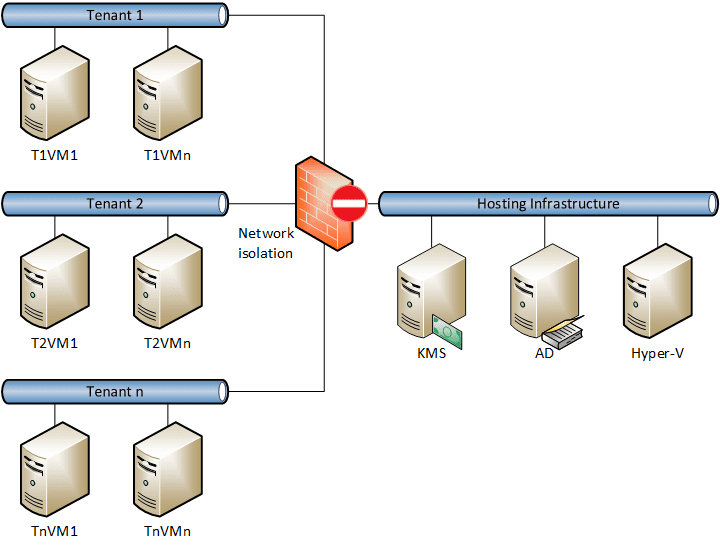
Today I will discuss how you can use a new feature in Windows Server 2012 R2 Hyper-V called Automatic Virtual Machine Activation (AVMA) to automatically activate the guest OS installations of Hyper-V virtual machines.
Why Automatic Virtual Machine Activation Is Required
Imagine a Hyper-V installation that is large or complex. There might be many isolated networks. Those networks could be isolated using either VLANs or Hyper-V Network Virtualization (HNV). There might be many Active Directory forests that have no external trusts. These are very real designs that must be implemented by large enterprises and hosting companies that are building multi-tenant clouds.
Anyone who has legally deployed Windows (hopefully that is all of you) since the days of Windows XP has had to activate their product key. There are three ways to do an activation:
- Online: Your machine connects directly to a Microsoft service on the Internet and activates. This is okay for a few installations, but it’s not scalable.
- Offline: If your activation fails or the machine is offline then you can call the Microsoft clearing house to perform the activation over the phone. This method is intended for rare occasions. I hope this isn’t what you plan for a network with dozens, hundreds, or even thousands of virtual machines.
- Key Management Service: A Key Management Service (KMS) installed, activated using a special KMS key, and advertised on the network. New machines are directed to the KMS instead of the Microsoft online service to activate. This is more scalable and removes the dependency for machines to have Internet access.
Initially it sounds like KMS activation is the perfect approach to use in a large-scale virtualization environment. In fact, it will work pretty well for a flat network where all virtual machines are in the same network or Active Directory as the hosting infrastructure where the KMS will likely reside.
But think about a true cloud for a moment, with its multi-tenancy, self-service, and broad network access. Lots of non-IT staff (I don’t mean the receptionist, but delegated IT outside of central infrastructure management) will be deploying virtual machines for themselves. Tenants, be they internal or external, must be isolated from the hosting infrastructure and each other. And how are the Windows Server operating systems of those virtual machines going to activate against a centrally deployed KMS server with which they cannot communicate?
Tenant VMs are isolated from Windows activation.
What Is AVMA?
You may have heard the line that “every Hyper-V feature of Windows Server Datacenter edition is in Windows Server Standard.” That was true in WS2012 and it is very nearly true in WS2012 R2. The one exception is related to licensing.
When you license a physical server with Windows Server Datacenter edition you are entitled to install it:
- On the physical server if you want to deploy Hyper-V
- In as many virtual machines as you can/want on that physical server
That makes licensing hosts (including vSphere) using the Datacenter edition the cheapest option for deploying hosts with lots of Windows Server virtual machines – you basically get unlimited installs of Windows Server on that host for the cost of licensing just the physical server for Window Server.
And this is why Microsoft added AVMA to just the Datacenter edition. AVMA provides a solution in which:
- You deploy Hyper-V on hosts using Window Server 2012 R2 Datacenter edition.
- WS2012 R2 virtual machine are deployed with a special AVMA key.
- The virtual machines detect the host is activated and they automatically activate without requiring external services such as KMS.
In short, AVMA simplifies Windows Server activation for larger deployments and for networks that must feature virtual machine isolation. The OS requirements are:
- The host must be running WS2012 R2 Datacenter edition
- The virtual machines must be running WS2012 R2 Essentials, Standard, or Datacenter edition
Installing the AVMA Key
There are two ways to deploy the AVMA key. The first is a more manual process in which you run the following command in the guest OS of a new virtual machine:
slmgr /ipk <AVMA_product_key>
Note: You can get the public (yes, they are public and intended to be used by everyone) AVMA product keys from TechNet.
The guest OS will communicate with the host via the Hyper-V integration components to attempt an activation. This process is repeated every seven days to ensure that mobile VMs are indeed running on activated hosts.
If you want to build lots of virtual machines, such as in a self-service cloud, then you should consider the alternative approach in which you include the AVMA product key in the unattended installation. This will remove the manual aspect of running SLMGR.
What are Automatic Virtual Machine Activation (AVMA) license keys?
Automatic Virtual Machine Activation (AVMA) is a feature that handles the Windows Server activation process for an instance of Windows Server as a VM Guest on Hyper-V Server.
AVMA lets you install virtual machines on a properly activated Windows server without having to manage product keys for each individual virtual machine, even in disconnected environments. AVMA binds the virtual machine activation to the licensed virtualization server and activates the virtual machine when it starts up. AVMA also provides real-time reporting on usage and historical data on the license state of the virtual machine. Reporting and tracking data is available on the virtualization server.
What are the Requirements to Use Automatic Virtual Machine Activation?
AVMA requires a Microsoft Virtualization Server running Windows Server 2019 Datacenter, Windows Server 2016 Datacenter, or Windows Server 2012 R2.
And below is the VM guest matrix that can use AVMA license:
| Server host version | Windows Server 2019 | Windows Server 2016 | Windows Server 2012 R2 |
|---|---|---|---|
| Windows Server 2019 | X | X | X |
| Windows Server 2016 | X | X | |
| Windows Server 2012 R2 | X |
AVMA keys
The following AVMA keys can be used for Windows Server 2019.
| Edition | AVMA key |
|---|---|
| Datacenter | H3RNG-8C32Q-Q8FRX-6TDXV-WMBMW |
| Standard | TNK62-RXVTB-4P47B-2D623-4GF74 |
| Essentials | 2CTP7-NHT64-BP62M-FV6GG-HFV28 |
The following AVMA keys can be used for Windows Server, version 1809.
| Edition | AVMA key |
|---|---|
| Datacenter | H3RNG-8C32Q-Q8FRX-6TDXV-WMBMW |
| Standard | TNK62-RXVTB-4P47B-2D623-4GF74 |
The following AVMA keys can be used for Windows Server, version 1803 and 1709.
| Edition | AVMA key |
|---|---|
| Datacenter | TMJ3Y-NTRTM-FJYXT-T22BY-CWG3J |
| Standard | C3RCX-M6NRP-6CXC9-TW2F2-4RHYD |
The following AVMA keys can be used for Windows Server 2016.
| Edition | AVMA key |
|---|---|
| Datacenter | TMJ3Y-NTRTM-FJYXT-T22BY-CWG3J |
| Standard | C3RCX-M6NRP-6CXC9-TW2F2-4RHYD |
| Essentials | B4YNW-62DX9-W8V6M-82649-MHBKQ |
The following AVMA keys can be used for Windows Server 2012 R2.
| Edition | AVMA key |
|---|---|
| Datacenter | Y4TGP-NPTV9-HTC2H-7MGQ3-DV4TW |
| Standard | DBGBW-NPF86-BJVTX-K3WKJ-MTB6V |
| Essentials | K2XGM-NMBT3-2R6Q8-WF2FK-P36R2 |
Reporting
You can use the script from Benjamin Amstrong to get KVP on the virtualization server. For the detail, you can check it here.
source: https://docs.microsoft.com/en-us/windows-server/get-started-19/vm-activation-19

